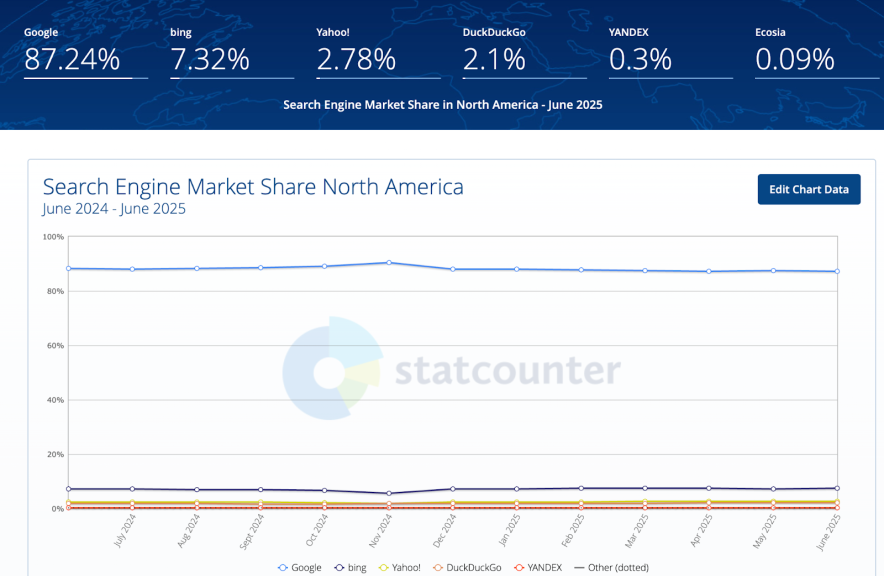Bing is the second-largest search engine after Google, available in 238 countries and regions worldwide and supporting 105 languages.
Bing handles over 100 million searches daily, demonstrating its widespread use. That adds up to around 27 billion searches each month, 37.5 million every hour, 625,000 every minute, and about 10,417 searches every second!
With powerful AI features like image generation and chat, Bing is now more than just a search engine.
The best part? Bing is integrated with Microsoft tools like Edge and Copilot, helping it grow even faster. In this post, let’s discover key stats about Bing, how it’s growing, and what makes it stand out in today’s search engine market.
Table of Contents
Editor’s Choice: Key Bing Statistics at a Glance
Here’s a quick summary of the most essential Bing stats for 2025.
- Bing currently holds a search engine market share of 4.01%, making it the clear #2 behind Google.
- In the United States, Bing commands about 17.58% of desktop search traffic as of mid-2025.
- Most Bing users are aged between 25 and 34 years (25.47%), followed by those aged 35–44 years (22.38%) and 18–24 years (19.46%).
- Bing’s ad revenue has gone up each year, growing from $8.52 billion in 2020 to $12.58 billion in 2024.
- Bing is estimated to be worth about $400 billion.
Bing Usage Insights
Bing is the second-largest search engine worldwide, holding a 4.01% market share. It’s primarily used in the U.S. and on desktop devices, with many users accessing it by default through Microsoft products, such as Windows and Edge.
Bing uses visual search and built-in AI to make searching easier and more helpful. Its AI features help users find answers more quickly and accurately.
Here are some of the key insights on Bing’s daily users, monthly unique visits, demographics, and more.
Bing Daily Active Users
Microsoft Bing has 100 million active users worldwide, with a large number coming from China and the United States. (The Verge and SimilarWeb)

Here’s a breakdown of the top countries generating the most visitors to Bing.
| Country | Traffic Share in % |
|---|---|
| China | 27.99% |
| United States | 22.55% |
| Japan | 5.28% |
| Germany | 3.79% |
| Brazil | 3.18% |
Bing Monthly Visitors & Unique Visits
As of June 2025, Bing attracts 1.4 billion visits each month. (SimilarWeb)
As of August 2025, Bing is used by 11.63% of desktop users, making it the second most used search engine on computers. On tablets, approximately 5.92% of users use Bing, while on mobile phones, only 2.29% of people use it, as most prefer Google on mobile devices.
Bing Demographics
Most Bing.com users are men (over 63%), with the largest age group being 25–34 years, comprising around 25% of the audience.
Most of Bing.com’s users are men, comprising approximately 63.66% of the audience. Women make up the remaining 36.34%.
Most Bing users are between 25 and 44 years old.

Here’s the Bing Users Age distribution of Bing.com’s audience;
| Age Group | Percentage of Audience |
|---|---|
| 25–34 years | 25.47% (largest group) |
| 35–44 years | 22.38% |
| 18–24 years | 19.46% |
| 45–54 years | 15.75% |
| 55–64 years | 10.01% |
| 65+ years | 6.93% |
Bing now holds a 4.01% share of the global search engine market. Although it lags behind Google, it still ranks among the top search engine alternatives.
As of 2025, Google remained the world’s top search engine, holding an 89.71% market share.
Here’s a comparison of Bing’s global share with Google, Yahoo, DuckDuckGo, and others since 2020. (Statista)
| Year | Bing | Yandex | Yahoo! | Baidu | DuckDuckGo | |
|---|---|---|---|---|---|---|
| 2020 | 92.51% | 2.45% | 0.38% | 1.64% | 1.1% | 0.44% |
| 2021 | 91.86% | 2.71% | 0.87% | 1.46% | 1.13% | 0.66% |
| 2022 | 91.9% | 2.88% | 1.28% | 1.51% | 1.14% | 0.69% |
| 2023 | 92.9% | 3.03% | 0.85% | 1.21% | 0.65% | 0.58% |
| 2024 | 91.47% | 3.43% | 1.78% | 1.1% | 0.83% | 0.54% |
| 2025 | 89.71% | 4.01% | 2.51% | 1.33% | 0.62% | 0.79% |
Wondering how many people use Spotify? See the latest Spotify stats in numbers.
Bing currently has a market share of 4.01%.

Here’s Bing’s global market share since 2009 (Statista)
| Year | Search Market Share of Bing |
|---|---|
| 2009 | 2.3% |
| 2010 | 3.46% |
| 2011 | 3.57% |
| 2012 | 3.09% |
| 2013 | 3.36% |
| 2014 | 3.63% |
| 2015 | 3.02% |
| 2016 | 2.79% |
| 2017 | 2.76% |
| 2018 | 2.82% |
| 2019 | 2.44% |
| 2020 | 2.45% |
| 2021 | 2.71% |
| 2022 | 2.88% |
| 2023 | 3.03% |
| 2024 | 3.43% |
| 2025 | 4.01% |
Desktop vs. Mobile vs. Tablet vs. Console
| Search Engine | Desktop Share | Mobile Share | Tablet Share |
|---|---|---|---|
| 79.49% | 93.72% | 89.26% | |
| Bing | 11.63% | 2.29% | 5.92% |
| Yahoo! | 2.95% | 0.81% | 2.33% |
| Yandex | 2.86% | 0.78% | 0.81% |
| DuckDuckGo | 1.07% | 0.73% | 0.77% |
| Baidu | 0.56% | 0.68% | 0.35% |
Source: StatCounter
The following table shows Bing’s 2025 search engine market share across key regions based on data from StatCounter:
| Region | Market Share (%) |
|---|---|
| United States | 7.41% |
| Europe | 4.05% |
| Canada | 6.56% |
Bing Ads & Revenue Statistics
Here are some of the latest insights on how Bing is performing in terms of ad revenue and advertising trends.
Total Bing Ads Revenue
Bing’s Search and news advertising revenue (excluding the cost of getting traffic) went up by 21% compared to last year.
| Quarter | Time Period | Bing Ad Revenue Growth |
|---|---|---|
| Q1 2025 | Jan – Mar 2025 | 21% |
| Q4 2024 | Oct – Dec 2024 | 21% |
| Q3 2024 | Jul – Sep 2024 | 18% |
| Q2 2024 | Apr – Jun 2024 | 19% |
| Q1 2024 | Jan – Mar 2024 | 12% |
| Q4 2023 | Oct – Dec 2023 | 8% |

Sources: Microsoft and Search Engine Roundtable
Year-over-Year Growth
Here’s a table showing Microsoft’s Bing search and news ad revenue from 2020 onwards:
| Year | Bing Ad Revenue from Search & News |
|---|---|
| 2020 | $8.52 billion |
| 2021 | $9.27 billion |
| 2022 | $11.59 billion |
| 2023 | $12.2 billion |
| 2024 | $12.58 billion |
New to SEO and not sure where to start? This SEO tutorial for beginners explains all the basics in easy steps.
Here’s a simple breakdown of year-over-year growth in Bing’s ad revenue from Search & News:
- 2021 vs 2020: Revenue grew from $8.52B to $9.27B → up $0.75B (about 9% increase)
- 2022 vs 2021: Revenue grew from $9.27B to $11.59B → up $2.32B (about 25% increase)
- 2023 vs 2022: Revenue grew from $11.59B to $12.2B → up $0.61B (about 5% increase)
- 2024 vs 2023: Revenue grew from $12.2B to $12.58B → up $0.38B (about 3% increase)
Bing’s ad revenue growth was strongest in 2022, but has slowed down each year since.
Bonus Read: Reddit generated over $1.3B in revenue in 2024. Take a look at the detailed Reddit Stats.
Microsoft Bing’s Valuation
Here’s some interesting data about Bing’s financial weight within Microsoft.
Estimated Market Value
Bing is estimated to be worth around $400 billion if considered on its own, apart from Microsoft. (HulkApps)
Quick Note: This value is just an estimate, as Microsoft doesn’t share separate financial details for Bing.
Bing’s Contribution to Microsoft’s Revenue
Microsoft’s search & news advertising (which includes Bing) generated about $12.5 billion in FY 2024, marking a 5% increase year-over-year.
Microsoft Advertising surpassed $10 billion in annual revenue by 2021, according to Wikipedia.
Growth Trends
According to The Wall Street Journal, Microsoft’s CFO, Amy Hood, stated that a 1% increase in Bing’s search share could generate approximately $2 billion more in ad revenue each year.
Bing vs Google
Here are some insights comparing Bing to its biggest competitor, Google.
Language and Country Availability
Google Search supports more languages (150+), making it easier for people around the world to use it in their local language. On the other hand, Bing is available in more countries and regions (238+).
| Feature | Bing Search | Google Search |
|---|---|---|
| Countries & regions served | Available in 238 countries and regions | Available in over 150 countries/regions |
| Languages supported | Offers search in 105 different languages | Supports more than 150 languages or dialects |
North America Dominance: Google Vs Bing
For every 100 people using a search engine in North America, about 87 use Google, while only 7 use Bing. (StatCounter)

According to StatCounter’s data, Google’s share has remained strong and steady over the past year. Bing’s market share is small and hasn’t changed much either.
User Base & Daily Use
Google has around 1 billion daily active users, while Bing sees about 100 million daily users, roughly one‑tenth of the audience. (Impression Digital)
Google vs Bing Ranking Factors
The illustration below provides a quick and simple overview of how Google and Bing’s ranking systems work and how they differ. (Impression Digital)

As shown above, Google focuses more on mobile-friendliness, site speed, JavaScript, backlinks, and fresh, helpful content. Bing gives more weight to keywords, .gov/.edu domains, and social media signals.
Want to know which websites get the most traffic? Check out this list of the most visited websites around the world.
Bing’s Competitive Edge
Here are a few things that make Bing stand out or excel in certain areas.
Key Differentiators in Search Technology
Bing introduced AI-powered features in its search in February 2024. According to The American Customer Satisfaction Index, Bing received a score of 75 out of 100, indicating that users are pretty satisfied, and this score has been improving over time.
AI-Powered Search In Bing
In just six months after adding AI features, Bing users started over 1 billion chats and created more than 750 million images. (Increv)
Integrations with Windows, Edge, and Office
Bing is deeply embedded within Microsoft’s product ecosystem.
- Windows: Bing powers the Search bar and shows news, weather, and web results.
- Edge Browser: Bing is the default search engine in its Edge browser.
- Microsoft Office: Bing helps Copilot in Word, Excel, and Outlook (for various tasks like writing, text summary, etc)
- Copilot AI: In April 2025, Microsoft introduced Copilot in Bing Search to provide direct and informative answers to most search queries. (Bing)
Curious how many people use voice search today? These voice search statistics show how it’s changing the way we search online.
Final Take: Is Bing Gaining Ground in 2025?
Bing is far behind the search giant Google.
However, Bing continues to grow slowly, thanks to its AI features and visual search tools that make browsing more interactive and user-friendly.
That’s why Bing remains an excellent alternative for many users worldwide.
So, what are your thoughts on Bing statistics? Did you find them interesting? Have any questions? Let us know in the comments.
FAQs On Bing Statistics 2025
Microsoft released the Bing search engine on June 3, 2009, replacing its previous Live Search platform.
Bing was estimated to be valued at over $400 billion.
Bing is the second-largest search engine globally with a market share of around 4%.
Before the rebrand, Bing was known under several names: MSN Search (1998–2006), Windows Live Search (2006–2007), and Live Search (2007–2009)
Within the first six months after launching AI features, Bing users initiated over 1 billion chats and created more than 750 million images.



